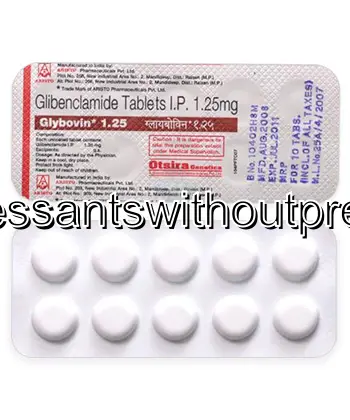| Package | Dosage | Price | Price per Dose | |
|---|---|---|---|---|
| Dosage: 2,5mg | ||||
| 360 pill | 2,5mg | €251.99 | €0.70 | |
| 180 pill | 2,5mg | €135.58 | €0.75 | |
| 120 pill | 2,5mg | €97.23 | €0.81 | |
| 90 pill | 2,5mg | €79.42 | €0.88 | |
| 60 pill | 2,5mg | €57.51 | €0.96 | |
| 30 pill | 2,5mg | €34.23 | €1.14 | |
| Dosage: 5mg | ||||
| 360 pill | 5mg | €221.86 | €0.62 | |
| 180 pill | 5mg | €128.73 | €0.71 | |
| 120 pill | 5mg | €90.38 | €0.75 | |
| 90 pill | 5mg | €71.20 | €0.79 | |
| 60 pill | 5mg | €49.29 | €0.82 | |
| 30 pill | 5mg | €28.75 | €0.96 | |

Glibenclamide Description
Overview of Glibenclamide
Glibenclamide, also known as glyburide in some regions, is an oral medication used primarily to manage type 2 diabetes mellitus. It belongs to the class of drugs called sulfonylureas, which work by stimulating the pancreas to produce more insulin. This increased insulin secretion helps to lower blood glucose levels, making it easier for patients to control their condition. Glibenclamide is often prescribed alongside diet and exercise modifications to improve overall blood sugar management.
How Glibenclamide Works
The medication acts on the beta cells of the pancreas, closing potassium channels and leading to cell depolarization. This process opens voltage-dependent calcium channels, prompting the beta cells to release insulin. The result is a decrease in blood sugar levels. Since it boosts the body's own insulin production, Glibenclamide is most effective in patients with some residual pancreatic function.
Benefits of Using Glibenclamide
Many patients find Glibenclamide effective in maintaining target blood sugar levels. It is advantageous due to its once-daily dosing in many cases, making adherence easier. The medication helps in reducing the risk of complications associated with uncontrolled diabetes such as nerve damage, eye problems, and kidney issues. Its affordability compared to some newer medications also makes it a common choice for many individuals managing their condition.
Possible Side Effects
Like all medications, Glibenclamide can cause side effects. The most common include hypoglycemia, or low blood sugar, which may cause symptoms like sweating, trembling, dizziness, and weakness. Some users may also experience gastrointestinal issues such as nausea or stomach upset. Allergic reactions are rare but possible, involving skin rashes or swelling. It is important to monitor blood sugar regularly while taking this medication and report any adverse effects to a healthcare provider promptly.
Precautions and Interactions
Glibenclamide should be used cautiously in certain populations, including elderly patients or those with liver or kidney impairment. It interacts with several other medications, such as beta-blockers, diuretics, or other antidiabetic drugs, which can increase the risk of hypoglycemia or alter its effectiveness. Patients should inform their healthcare provider about all medications they are using. Alcohol consumption should be avoided as it can enhance the blood sugar-lowering effect and increase hypoglycemia risk.
Usage and Dosage
The dosage of Glibenclamide varies according to individual needs and response to treatment. It is typically started at a low dose, gradually increased to achieve optimal blood glucose control. Compliance with prescribed instructions is vital for safety and effectiveness. Patients should take the medication with breakfast or the first main meal of the day. Regular blood sugar monitoring is essential to adjust the dose as necessary.
Conclusion
Glibenclamide remains a reliable option for many people with type 2 diabetes, especially in areas where cost and availability are concerns. Proper use, regular monitoring, and awareness of potential side effects are important to maximize benefits and minimize risks. Patients should always follow their healthcare provider's guidance and report any unusual symptoms or concerns promptly.